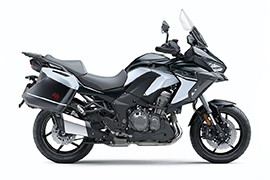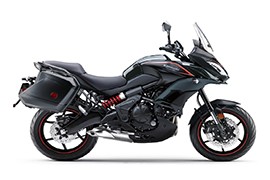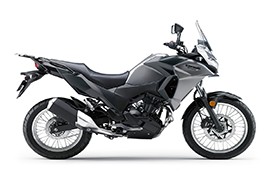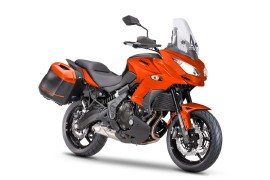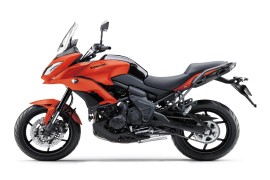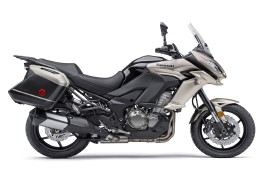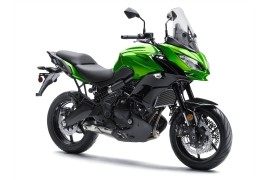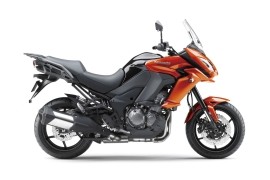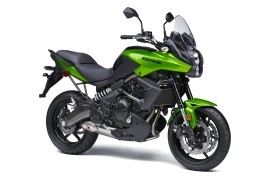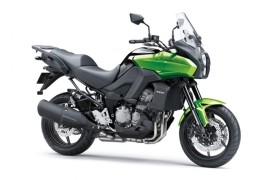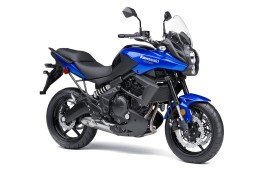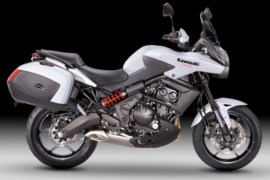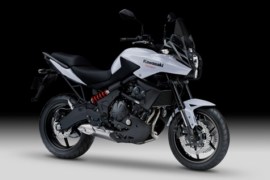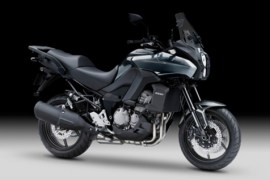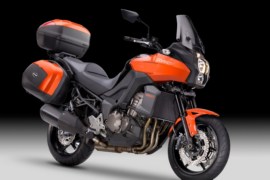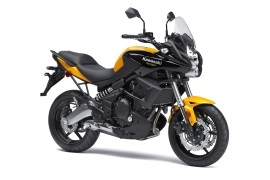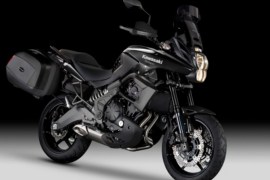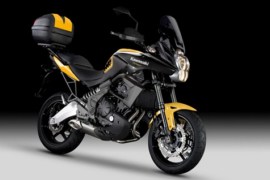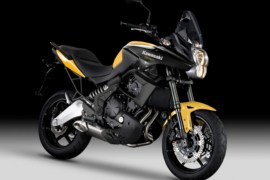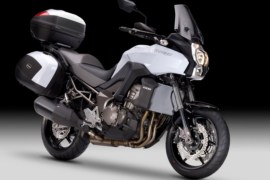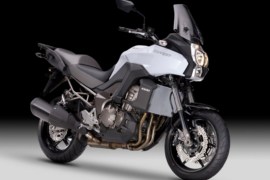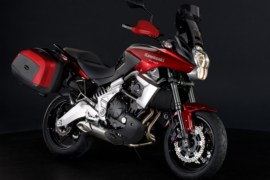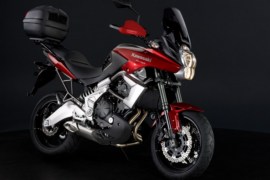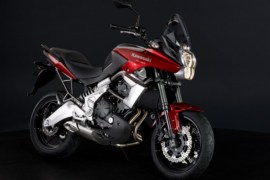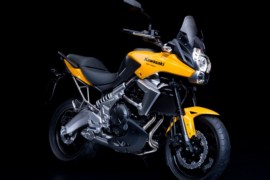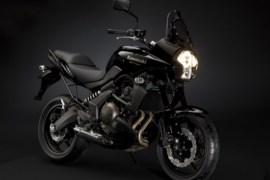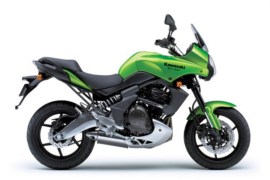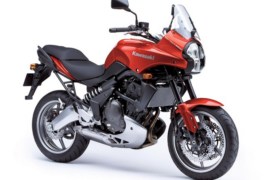KAWASAKI VERSYS Models/Series Timeline, Specifications & Photos
First production year: 2006
In 2018, at the EICMA Motorcycle Show, Kawasaki presented the Versys 1000 SE LT +, their largest displacement tourer that came as a 2019 model with several updates such as a revised styling, which made it look more like the new-age Kawasakis's motorcycles, with added cornering lights, and other upgrades in the technical and electrical departments.
The new model featured an electronic throttle valves system that offered ride-by-wire tech, a six-axis IMU, and an electronically adjustable suspension system previously seen on the ZX-10R SE model, which offered four riding modes such as Rain, Road, Sport, and Individual.
As a protection feature, the SE LT + model came with a taller manually-adjustable windscreen that prevented the turbulence at high speeds created by the previous model, with vents that channelized the airflow and also reduced back pressure.
The ergonomics and the frame of the sport tourer motorcycle were carried from the previous generation, with the same engine used as a stressed member of the chassis that featured the same power end torque characteristics.
The 2019 Kawasaki Versys 1000 SE LT + took its thrust from a 1,043cc four-stroke four-cylinder liquid-cooled fuel-injected engine that delivered an output power of 118 hp with a peak at 9,000 rpm and 102 Nm (75 lb-ft) of torque available at 7,700 rpm.
For braking performance, the bike packed two 300 mm discs with four-piston calipers on the front wheel and a 250 mm disc squeezed by a single-piston caliper on the rear wheel.
The Kawasaki Versys 650 was a middleweight motorcycle first introduced by the Japanese motorcycle manufacturer as a 2007 model in the European and Canadian markets and as a 2008 model in the US market.
The bike was made with borrowed design elements from dual-sportbikes, standard, adventure tourers, and even sportbikes, but not fitting into any of those categories.
The Versys was based on the same platform as other Kawasaki 650cc twin-engined motorcycles, like the Ninja 650R and ER-6N, which shared its electronics, engine, wheels, brakes, and mainframe, but the Versys was different with its riding position, rear subframe, suspension, and engine tunning.
With several revisions over the years, the Japanese motorcycle manufacturer launched the 2018 Kawasaki Versys 650 LT, a middleweight tourer that had the same features as the standard ABS version, but with additional Kawasaki Quick Release (KQR) 28-liter saddlebags and hand guard as standard options, which enhanced its touring capabilities.
In the performance department, the 2018 Kawasaki Versys 650 LT took its thrust from a 649cc four-stroke parallel-twin liquid-cooled engine that delivered an output power of 69 hp at 8,500 rpm and 64 Nm (48 lb-ft) of torque with a peak at 7,000 rpm.
As for suspension, the bike packed a Showa front fork derived from the Kawasaki Ninja sportbikes, which featured rebound damping adjustability in the right fork leg and spring preload in the left fork leg, while the rear was handled by a single shock absorber with remote hydraulic preload adjuster.
In late 2016, Kawasaki announced the Versys-X300, the smallest model in the Versys range of motorcycles intended for those riders who wanted a lightweight, maneuverable machine that would handle everyday commuting, touring, and even off-roading.
The production of the Kawasaki Versys-X 300 started with the 2017 model, powered by a 300cc engine and also intended for shorter riders with its relatively low seat height of 815 mm. It also featured an optional extended-reach saddle that raised the seat height by 25 mm.
The parallel-twin liquid-cooled engine was taken from the Kawasaki Ninja 300 and modified for more torque at lower rpm to suit its off-road capabilities. In the US market, the bike was sold with optional ABS, while in the Australian and Canadian markets, the bike was sold with ABS as a standard option.
The Versys-X 300 featured a new steel backbone frame that used the engine as a stressed member, which added to its rigidity and lightweight, while the suspension performance was handled by a long-travel 41 mm telescopic fork on the front and a Uni-Trak gas-charged shock absorber on the rear.
In the performance department, the 2017 Kawasaki Versys-X 300 had at its core a 296cc four-stroke parallel-twin liquid-cooled engine that delivered an output power of 40 hp with a peak at 11,500 rpm and 26 Nm (19 lb-ft) of torque available at 10,000 rpm.
In 2016, the Kawasaki Versys 650 released by the Japanese motorcycle manufacturer was offered in two versions, such as the ABS model and the Tourer version which featured the same specifications as the standard bike but with only a few changes.
In addition to the standard Versys ABS model, the Tourer version featured two 28-liter color-matched saddlebags that were unlocked and removed by the same key used for the ignition and standard hand guards that enhanced its touring capabilities.
The 2016 Kawasaki Versys 650 LT featured a new rear subframe that accommodated the Kawasaki Quick Release (KQR) mounting system and an additional top case. Also, the footpegs location was altered on both machines, moving them 15 mm lower and 20 mm forward, which enhanced the overall comfort.
Other changes included a larger windscreen with tool-less vertical adjustability, completely updated styling, a fully adjustable Showa fork on the front, a KYB shock absorber on the rear with remote preload adjustability, and both front and rear Nissin calipers with two 300 mm discs on the front and 250 mm discs on the rear.
In the performance department, the 2016 Kawasaki Versys 650 Tourer had at its core a 649cc four-stroke parallel-twin liquid-cooled engine that delivered an output power of 69 hp with a peak at 8,500 rpm and 64 Nm (48 lb-ft) of torque available at 7,000 rpm.
In 2016, Kawasaki released the Versys 650, a motorcycle that featured the same upgrades as the 2015 model, such as new dramatic styling, more power and torque, improved comfort, and fewer vibrations with the rubber-mounted engine and handlebar, and a new suspension system that enhanced the already plush ride of its predecessor.
With the combination of the long-travel suspension with the 17 inches sporty wheels and the slim upright riding position with the low-mid range focused engine, the result was a versatile package that offered maximum riding excitement.
The 2016 Kawasaki Versys 650 was offered in two versions, such as the ABS version that featured top-notch Kawasaki performance and maneuverability and the LT model that came with the same specifications as the ABS bike, but with added color-matched saddlebags that featured the Kawasaki Quick Release (KQR) mounting system and gloss black hand guards that enhanced its touring capabilities.
In the performance department, the 2016 Kawasaki Versys 650 ABS had its heartbeat set by a 649cc four-stroke parallel-twin liquid-cooled engine that delivered an output power of 69 hp with a peak at 8,500 rpm and 64 Nm (48 lb-ft) of torque available at 7,000 rpm.
As for braking performance, the bike packed two 300 mm petal discs with two-piston calipers on the front wheel and a 220 mm petal disc with a single-piston caliper on the rear wheel that provided strong braking power.
In 2016, the Japanese motorcycle manufacturer launched the Kawasaki Versys 1000 LT, which was first introduced to the US market in 2015 the model continued as the ultimate asphalt, adventure, street touring machine with its comfortable upright seating position, adjustable suspension, and engine that delivered plenty of power and torque along with legendary Kawasaki dependability.
The bike was loaded with features that complemented the powerful engine, such as the three-mode Kawasaki Traction Control (KTRC) system, selectable engine power modes, economical riding indicator, ABS brakes, and the Assist and Slipper Clutch system.
The long-travel suspension contributed to the comfort of the 2016 Kawasaki Versys 1000 LT motorcycle, while the Candy Lime Green with Metallic Spark Black and Metallic Raw Titanium with Metallic Spark Black color schemes gave it a distinctive look.
In the power department, the 2015 Kawasaki Versys 1000 LT was powered by a 1,043cc four-stroke four-cylinder liquid-cooled engine that delivered an output power of 118 hp with a peak at 9,000 rpm and 102 Nm (75 lb-ft) of torque available at 7,700 rpm.
As for braking performance, the bike packed two 300 mm petal discs with four-piston calipers on the front wheel and a 250 mm petal disc squeezed by a single-piston caliper on the rear wheel.
Also, the Versys 1000 LT model packed a set of color-matched 28-liter composite side-cases that featured the Kawasaki Quick Release (KQR) system and a convenient one-key system for ignition, side-case unlocking, and removal.
In 2015, the Japanese motorcycle manufacturer launched the Kawasaki Versys 650 ABS, a multi-talented middleweight motorcycle that came with several upgrades such as new styling, more power and torque, improved comfort, and a new suspension that enhanced the already plush ride featured by its predecessor.
Some of the new features brought upon the Versys 650 ABS included a new front-end style with an aggressive and functional design, repositioned footpegs and rubber-mounted engine for fewer vibrations, a new larger windshield with increased adjustability for more wind protection, and a new Showa front suspension with a KYB rear shock absorber.
In addition, the bike also featured new passenger grips, Kawasaki Quick Release (KQR) saddlebag mounting system, a larger fuel tank for more range, new brake master cylinders with Nissin calipers, and more power and torque.
In the visual department, the bike came with a new dynamic style and an aggressive appearance inspired by Kawasaki's motorcycle heritage. The front fairing featured a functional design and instead of the vertically stacked headlights, Kawasaki fitted two horizontal headlights that represented the sportbike heritage in a unique Versys package.
In the performance department, the engine was fitted with a new one-piece exhaust system that boosted the high-rpm power matched by Electronic Control Unit (ECU) changes, which also improved fuel efficiency.
As for the power figures, the 2015 Kawasaki Versys 650 ABS took its thrust from a 1,043cc four-stroke parallel-twin liquid-cooled engine that delivered an output power of 69 hp with a peak at 8,500 rpm and 64 Nm (47 lb-ft) of torque at 7,000 rpm.
In 2015, Kawasaki released the Versys 1000 ABS, a motorcycle specifically designed to keep the rider behind the handlebars as long as possible, whether around the corner on a daily commute, across the globe, or even into space, the bike was ready for the job.
To maximize the Versys 1000 's fun factor, the engineers wanted to pick the most exciting engine possible that would deliver more than performance figures, so the chosen one was a 1,043cc four-cylinder engine that provided crisp throttle response and strong torque across the rpm range.
In the performance department, the 2015 Kawasaki Versys 1000 ABS had its heartbeat set by a 1,043cc four-stroke four-cylinder liquid-cooled engine that delivered an output power of 118 hp with a peak at 9,000 rpm and 102 Nm (75 lb-ft) of torque available at 7,700 rpm.
The bike came with a lightweight and rigid aluminum twin-tube frame that featured beams over the engine for a narrower construction, which offered easier grip with the knees, while the frame used the engine as a stressed member for more rigidity.
Also, the model was fitted with the Kawasaki Traction Control (KTRC) system that offered three riding modes for a variety of riding conditions, which provided enhanced sport riding performance or safer conditions with limited power.
The bike also featured a Power Mode Selection system that allowed the riders to set power delivery after their own preferences or riding conditions, with the low power mode that provided 75 percent power and the full power mode that unleashed the full potential of the engine.
The 2014 Kawasaki Versys 650 ABS, as its name says, came with enhanced stopping power thanks to the standard ABS that added more peace of mind on hard braking or slippery surfaces, which prevented the wheels from locking and the bike from sliding out of control.
The bike featured a sport-touring character along with a high ground clearance that made it handle a wide range of terrains in a comfortable and maneuverable manner while being considered one of the best bikes in its class.
At the heart of the bike was a compact 649cc parallel-twin engine, which was the most compact unit in its category that delivered plenty of power perfect for both city and highway streets. The compact engine's power was delivered to the rear wheel through a modern six-speed transmission that featured a compact design for easier maintenance.
As for the power figures, the 2014 Kawasaki Versys 650 ABS took its thrust from a 649cc four-stroke parallel-twin liquid-cooled engine that delivered an output power of 64 hp with a peak at 8,000 rpm and 61 Nm (45 lb-ft) of torque available at 6,800 rpm.
Besides the engine, another great feature that transformed the bike into a do-it-all machine was the long-travel, high-tech suspension that included an adjustable 41 mm inverted fork on the front and a Showa rear shock absorber that feature 13-way adjustable rebound damping and seven-way adjustable preload.
In addition, the bike featured rubber bushings at the rear engine mounts along with hollow rubber-covered footpegs that reduced vibrations and offered a more comfortable ride.
In 2014, the Japanese motorcycle manufacturer released the Kawasaki Versys 1000 ABS, one of the most versatile motorcycles designed by Kawasaki, powered by a 1,043cc engine fed from a 21-liter fuel tank that offered almost 400 km (249 miles) range and a power mode feature that allowed the rider to choose between low and full power.
The bike featured a lightweight and rigid aluminum twin-tube frame with beams that embraced the engine for a narrower construction, which offered an easier grip with the knees, while the frame used the engine as a stressed member for more rigidity.
The bike rolled on a set of six-spoke wheels that were ideal for a multi-purpose machine, shoded with Pirelli Scorpion Trail tires that matched the chassis and offered excellent stability at highway speeds and good grip on various road conditions.
Also, the bodywork was fully functional and designed for increased wind protection with its voluminous front cowling sides and side fairings that also protected the rider’s legs from the elements.
In the performance department, the 2014 Kawasaki Versys 1000 ABS had at its core a 1,043cc four-stroke four-cylinder liquid-cooled engine that delivered an output power of 118 hp with a peak at 9,000 rpm and 102 Nm (75 lb-ft) of torque available at 7,700 rpm.
As for braking performance, the model packed two 300 mm petal discs with four-piston calipers on the front wheel and a 250 mm petal disc squeezed by a single-piston caliper on the rear wheel.
The Kawasaki Versys entered in 2013 with the same versatile design and comfort-minded architecture as its predecessors, suitable for multiple scenarios, such as everyday commuting, longer journeys, and even light off-road ridings.
The 2013 Kawasaki Versys 650 featured the most compact engine in its class that allowed the construction of a smaller, lighter, and narrower machine resulting in more maneuverability.
The key to the Versys’s success was the carefully designed cockpit that offered a natural, upright seating position with a two-piece seat that provided optimum comfort for the rider and passenger, a three-way adjustable windscreen, and an easy-to-read instrument cluster.
In the power department, the 2013 Kawasaki Versys had at its core a 649cc four-stroke parallel-twin liquid-cooled engine that delivered an output power of 64 hp with a peak at 8,000 rpm and 61 Nm (45 lb-ft) of torque available at 6,800 rpm.
Mounted onto the small, light, and narrow trellis frame, the suspension offered a plush ride thanks to its 41 mm long-travel inverted fork on the front that provided excellent performance in various riding conditions and a single-shock absorber on the rear that featured preload and rebound adjustability.
As for the braking performance, the 2013 Kawasaki Versys packed two 300 mm petal discs with two-piston calipers on the front wheel and a 220 mm disc squeezed by a single-piston caliper on the rear wheel.
The Kawasaki Versys Tourer was released by the Japanese motorcycle manufacturer in 2013, as a middleweight motorcycle that packed all the nifty features of the modern Versys series, such as a powerful and dependable engine, top-end adjustable suspension, and a redesigned bodywork that came with some extra features.
For starters, the pannier system offered by Kawasaki included two side saddlebags with 35-liter of storage for longer journeys and two custom premium nylon bags, while the three-way adjustable windshield provided optimum weather protection at all speeds.
In addition, the bike featured aluminum-reinforced hand guards, a branded gel resin tank protector that enhanced the appearance and protected the fuel tank from scratches, and a redesigned seat with better ergonomics that provided more comfort for the rider and passenger.
The bike featured a carefully designed cockpit that offered a natural, upright seating position with a two-piece seat and an easy-to-read instrument cluster, and for more comfort, the engine was fitted with rubber mounts for reduced vibrations.
In the performance department, the 2013 Kawasaki Versys Tourer took its thrust from a 649cc four-stroke parallel-twin liquid-cooled engine that delivered an output power of 64 hp with a peak at 8,000 rpm and 61 Nm (45 lb-ft) of torque available at 6,800 rpm.
As for braking performance, the bike packed two 300 mm semi-floating petal discs with dual-piston calipers on the front wheel and a 220 mm petal disc with a single-piston caliper on the rear wheel.
In 2013, the Japanese motorcycle manufacturer released the Kawasaki Versys, a comfortable machine with a serious sporty attitude and aggressive styling that complemented its dynamic flexibility and strength.
The key to Versys’s success was the carefully designed cockpit that offered a natural, upright seating position with a two-piece seat that provided optimum comfort for the rider and passenger, a three-way adjustable windscreen, and an easy-to-read instrument cluster.
The bike featured a 649cc parallel-twin engine that was perfect for the nimble machine, powerful enough for the advanced riders and predictable enough for the inexperienced ones, with power delivery in the low-mid rpm range.
In the power department, the 2013 Kawasaki Versys had at its core a 649cc four-stroke parallel-twin liquid-cooled engine that delivered an output power of 64 hp with a peak at 8,000 rpm and 61 Nm (45 lb-ft) of torque available at 6,800 rpm.
Mounted onto the small, light, and narrow trellis frame, the suspension offered a plush ride thanks to its 41 mm long-travel inverted fork on the front that provided excellent performance in various riding conditions and a single-shock absorber on the rear that featured preload and rebound adjustability.
As for the braking performance, the 2013 Kawasaki Versys packed two 300 mm petal discs with two-piston calipers on the front wheel and a 220 mm disc squeezed by a single-piston caliper on the rear wheel.
In 2013, the Japanese motorcycle manufacturer launched the Kawasaki Versys 1000, a motorcycle carefully designed to offer a high level of refinement, comfort, and reliability, which also featured a contemporary cutting-edge style that combined the classic Kawasaki lines with modern details.
The bike was created as a big brother to the mid-size Kawasaki Versys motorcycle and was designed to provide the greatest riding enjoyment in the widest variety of riding conditions. Also, the model combined the highly responsive 1,043cc engine tuned for flexibility with a nimble chassis and dynamic suspension that offered a smooth and comfortable ride.
In the braking department, the Versys 1000 packed two 300 mm petal discs squeezed by a couple of four-piston calipers on the front wheel and a 250 mm petal disc with a single-piston caliper on the rear that provided strong braking performance.
The smooth riding characteristics were achieved by a 43 mm inverted long travel fork on the front and a horizontal back-link gas-charged shock absorber with long travel on the rear.
In the power department, the bike featured a 1,043cc engine that provided great throttle response and strong torque in the low-mid rpm range. As for the power figures, the 2013 Kawasaki Versys 1000, with its 1,043cc four-stroke four-cylinder liquid-cooled engine, delivered an output power of 118 hp with a peak at 9,000 rpm and 102 Nm (75 lb-ft) of torque available at 7,700 rpm.
Also, the 2013 Versys came with a three-mode Kawasaki Traction Control (KTRC) system and a Power Mode Selector that allowed the rider to choose between the two modes for personal preferences of various riding conditions.
In 2012, the Japanese motorcycle manufacturer released the Kawasaki Versys 1000 Grand Tourer, a dual-sport machine with additional touring-oriented features, offering a more comfortable and enjoyable riding experience.
The 2012 motorcycle was fitted with standard features, such as a dual-lamp single headlight unit up front, a three-way adjustable windscreen, a dual seat, an under-belly exhaust system with a silencer mounted on the right side, six-spoke aluminum wheels, and panniers.
In the storage department, the Kawasaki Grand Tourer had installed a large top case on a powder-coated luggage rack and side-mounted panniers that summed 117 liters of storage space, making it suitable for long-range journeys.
The bike was built on an aluminum twin-tube frame with an adjustable 43 mm inverted telescopic fork on the front and an adjustable horizontal back-link gas-charged shock absorber on the rear, offering excellent handling capabilities.
In the braking department, the bike's wheels were fitted with two 300 mm semi-floating petal discs coupled to a four-piston caliper on the front wheel and a 250 mm petal disc tied to a single-piston caliper on the rear wheel.
The 2012 Kawasaki Versys 1000 Grand Tourer had installed underneath its fuel tank a 1,043cc four-stroke four-cylinder liquid-cooled engine fed by an electronically controlled fuel injection system, delivering 118 hp at 9,000 rpm and 102 Nm (75 lb-ft) torque at 7,700 rpm.
In 2012, the Japanese motorcycle manufacturer launched the Kawasaki Versys, a middleweight naked street bike that carried on the heritage of the older KLE models with awesome maneuverability, comfortable upright riding position, great commuting capabilities, and serious touring potential with its optional accessories.
The bike offered a slim and aggressive design with plenty of nifty functional features, such as the compact end easy-to-read instrument cluster, redesigned rider and passenger seats, dual-lamp headlight, LED taillight, and turn signals, and as an option, the bike was available with ABS for safer braking on difficult surfaces.
Also, the bike offered great ergonomics, with its two-piece seat where each section was made with a different thickness and firmness foam that optimized rider and passenger comfort the passenger grab bars were designed for an upright seating position that added to the comfort, and an easy-to-read instrument cluster that offered a large analog tachometer and a digital readout for the speedometer, fuel gauge, odometer, and more.
In the performance department, the 2012 Kawasaki Versys had its heartbeat set by a 649cc four-stroke parallel-twin liquid-cooled engine that delivered an output power of 64 hp with a peak at 8,000 rpm and 61 Nm (45 lb-ft) of torque available at 6,800 rpm.
As for braking performance, the bike packed two 300 mm petal-shaped discs with two-piston calipers on the front and a 220 mm petal disc with a single-piston caliper on the rear.
In 2011, the Japanese motorcycle maker launched the Kawasaki Versys Tourer, a middleweight motorcycle that could run on both city streets and rougher roads, boasting features that make the ride safe and fun at the same time.
The Kawasaki Versys was a middleweight motorcycle, first released in 2007 as a replacement for the Kawasaki KLE500, continuing production until the present (2023). It borrowed design elements from standard, dual-sport, adventure tourers, and sports bikes.
The 2011 Kawasaki Versys Tourer had standard features, like a single headlight unit, a small three-way adjustable windscreen, aluminum-reinforced hand guards, a two-piece dual seat with passenger grab handles, side-mounted 35-liter hard panniers, an under-belly exhaust system, and six-spoke lightweight aluminum wheels.
The motorcycle was built on a diamond high tensile steel frame with an adjustable 41 mm inverted telescopic fork on the front and an adjustable offset lay-down shock absorber on the rear, offering excellent suspension performance and handling.
In the braking department, the bike packed two 300 mm semi-floating petal discs coupled to dual-piston calipers on the front wheel and a 220 mm petal disc with a single-piston caliper on the rear wheel, offering optimum suspension performance.
As for the power figures, the 2011 Kawasaki Versys Tourer had its soul brought to life by a 649cc four-stroke parallel-twin liquid-cooled engine that delivered an output power of 64 hp at 8,000 rpm and 61 Nm (45 lb-ft) torque at 6,800 rpm.
In 2011, the Japanese motorcycle maker released the Kawasaki Versys City, a middleweight motorcycle that packed all the nifty features of the base model but with additional wind protection features and storage options.
The Kawasaki Versys was a middleweight motorcycle, also known as the KLE650, that borrowed design elements from dual-sport, adventure tourers, sports bikes, and standard motorcycles. The Versys name was a combination of versatile and system words.
The 2011 Kawasaki Versys City version was equipped with a taller windscreen for more wind protection and aluminum-reinforced hand guards. Also, the fuel tank had self-adhesive resin gel pads, protecting it from occasional scratches.
At the rear, the bike was fitted with a 30-liter top case placed on a powder-coated luggage rack with integrated passenger grab handles and offered enough storage to fit almost any full-face helmet.
In the performance department, the bike had the same specifications as the previous model, packing a 649cc four-stroke parallel-twin liquid-cooled engine managed by a fuel injection system, delivering 64 hp with a peak force at 8,000 rpm and 61 Nm (45 lb-ft) torque at 6,800 rpm.
As for braking performance, the bike's six-spoke aluminum wheels were fitted with two semi-floating 300 mm petal discs coupled to dual-piston calipers on the front and a 220 mm petal disc with a single-piston caliper on the rear wheel, offering optimum stopping power.
In 2012, the Japanese motorcycle manufacturer launched the Kawasaki Versys, a middleweight naked street bike that carried on the heritage of the older KLE models with awesome maneuverability, comfortable upright riding position, great commuting capabilities, and serious touring potential with its optional accessories.
The bike offered a slim and aggressive design with plenty of nifty functional features, such as the compact end easy-to-read instrument cluster, redesigned rider and passenger seats, dual-lamp headlight, LED taillight, and turn signals, and as an option, the bike was available with ABS for safer braking on difficult surfaces.
Also, the bike offered great ergonomics, with its two-piece seat where each section was made with a different thickness and firmness foam that optimized rider and passenger comfort the passenger grab bars were designed for an upright seating position that added to the comfort, and an easy-to-read instrument cluster that offered a large analog tachometer and a digital readout for the speedometer, fuel gauge, odometer, and more.
In the performance department, the 2012 Kawasaki Versys had its heartbeat set by a 649cc four-stroke parallel-twin liquid-cooled engine that delivered an output power of 64 hp with a peak at 8,000 rpm and 61 Nm (45 lb-ft) of torque available at 6,800 rpm.
As for braking performance, the bike packed two 300 mm petal-shaped discs with two-piston calipers on the front and a 220 mm petal disc with a single-piston caliper on the rear.
In 2012, the Japanese motorcycle manufacturer launched the Kawasaki Versys 1000 Grand Tourer, a motorcycle that combined the modern cutting-edge style with Kawasaki's exclusive engineering style, which resulted in a multi-purpose machine with great flexibility.
The bike came as standard with a complete set of color-coded panniers and a top case that provided a maximum of 47-liter storage space, with the ability to swallow a full-face helmet and a top-quality gel-resin self-adhesive tank protector.
The model was fitted with a three-mode Kawasaki Traction Control (KTRC) system as on the 2012 ZZR1400 flagship model, which combined the best elements of the two traction control systems S-KTRC and KTRC that offered three riding modes and four various riding conditions.
A power mode selector allowed the rider to choose from two modes for personal preferences or various riding conditions, with Low Power Mode that limited the output to 75 percent for a milder throttle response and Full Power Mode that unleashed the full potential of the 1,043cc engine.
Also, the Kawasaki Versys 1000 featured a 30 mm height adjustable windscreen and a functional bodywork designed for increased wind protection with its front cowling sides and side fairings that contributed to the overall rider comfort.
The 2012 Kawasaki Versys 1000 Grand Tourer was powered by a 1,043cc four-stroke four-cylinder liquid-cooled engine that delivered an output power of 118 hp with a peak at 9,000 rpm and 102 Nm (75 lb-ft) of torque available at 7,700 rpm.
In 2012, the Japanese motorcycle manufacturer released the Kawasaki Versys 1000, the bigger brother of the Versys 650, as an answer to the demanding riders that were looking for a dynamic machine in the category.
The Versys 1000 was designed to offer the greatest riding enjoyment in a variety of riding conditions, with its highly responsive four-cylinder engine tuned for flexibility and its nimble chassis fitted with dynamic suspension.
The smooth riding of the Versys 1000 was generated by a 43 mm inverted fork with rebound damping and adjustable spring preload on the front and a horizontal back-link gas-charged shock absorber with rebound damping and adjustable remote spring preload on the rear.
The suspension was bolted to an aluminum tube frame with beams reaching over the engine for a narrow design and came in a lightweight and highly rigid package with the engine used as a stressed member of the chassis, which resulted in good stability and nimble handling.
The bike rolled on a set of lightweight six-spoke wheels shoded with Pirelli Scorpion Trail tires and fitted with two 300 mm discs with four-piston calipers on the front wheel and a 250 mm disc squeezed by a single-piston caliper on the rear wheel acting as braking performance.
In the performance department, the 2012 Kawasaki Versys 1000 took its thrust from a 1,043cc four-stroke four-cylinder liquid-cooled engine that delivered an output power of 118 hp with a peak at 9,000 rpm and 102 Nm (75 lb-ft) of torque available at 7,700 rpm.
The Kawasaki Versys 650 was a middleweight motorcycle that debuted in 2007 as a replacement for the Kawasaki KLE500 and continued production until the present (2023). The bike borrowed design elements from standard, dual-sport, adventure tourers, and sports bikes.
In 2010, the Japanese motorcycle manufacturer launched the Kawasaki Versys Tourer, a middleweight motorcycle that could handle both city streets and rougher roads, boasting features that make the ride both safe and fun.
It features a new bodywork and a dual-lamp headlight, a three-way adjustable windscreen for better protection at any speed, resin gel protectors on the fuel tank, keeping it scratch-free, and aluminum-reinforced hand guards.
In the visual department, the Tourer was fitted with standard features, such as a tall windscreen, a two-piece dual seat with passenger grab handles, side-mounted hard panniers, an under-belly exhaust system, and six-spoke lightweight wheels.
The motorcycle was built on a diamond high tensile steel frame with a 41 mm adjustable inverted telescopic fork on the front and an offset lay-down adjustable shock absorber on the rear, offering excellent handling.
The braking power was achieved by two semi-floating 300 mm petal discs coupled to dual-piston calipers on the front wheel and a 220 mm petal disc with a single-piston caliper on the rear wheel.
At its core, the 2010 Kawasaki Versys Tourer had installed a 649cc four-stroke parallel-twin engine with a fuel injection system in charge, delivering 64 hp at 8,000 rpm and 61 Nm (45 lb-ft) torque at 6,800 rpm.
The Kawasaki Versys, also known as the KLE650, was a middleweight motorcycle that borrowed design elements from dual-sport, adventure tourers, sports bikes, and standard motorcycles. The Versys name was a portmanteau of the versatile and system words.
In 2010, the bike received several styling changes, including headlights, fairings, and functional modifications, such as enlarged mirrors for better visibility and improved rubber engine mounts for fewer vibrations.
In 2010, the Japanese motorcycle manufacturer launched the Kawasaki Versys City, a version that packed all the nifty features of the standard model but with additional wind protection features and storage options.
The 2010 City model had a taller windscreen for more wind protection and aluminum-reinforced hand guards. In addition, the fuel tank was fitted with self-adhesive resin gel pads, protecting it from scratches.
Also, at the machine's rear end, the manufacturer installed a 30-liter top case mounted on a powder-coated luggage rack with integrated passenger grab handles. The top case offered enough storage to fit almost any full-face helmet.
In the performance department, the 2010 Kawasaki Versys City had installed a 649cc four-stroke parallel-twin liquid-cooled engine fed by an electronically controlled fuel injection system underneath its fuel tank.
As for the power figures, the engine delivered 64 hp at 8,000 rpm and 61 Nm (45 lb-ft) torque at 6,800 rpm, capable of sending the bike to a top speed of 197 kph (122 mph).
The 2011 Kawasaki Versys was a modern middleweight naked bike suitable for both daily commuting and touring around the country. Inheriting the excellent handling and comfortable, upright seating position of the older KLE models, the new Versys offered a great experience for both rider and passenger.
The 2011 model featured the redesigned and revised elements of its 2010 predecessor, such as the bodywork that added a sharper style, with a dual-headlamp headlight and a slender front cowl, new seats, and an overall slimmer appearance.
The long-travel high-tech suspension was mandatory for the bike's multi-role mission, with a long-travel fork on the front that delivered excellent performance over a wide range of conditions and an adjustable rear Showa single shock absorber on the rear that offered progressive damping as suspension load increased.
Other key features of the 2011 Kawasaki Versys included the lightweight aluminum swingarm, lightweight cast aluminum wheels, a three-way adjustable windscreen that offered great wind protection, an under-engine exhaust system that provided better weight centralization, and an aggressive style that offered a distinctive look.
In the power department, the 2011 Kawasaki Versys featured the most compact 649cc four-stroke parallel-twin liquid-cooled engine in its class that delivered an output power of 64 hp with a peak at 8,000 rpm and 61 Nm (45 lb-ft) of torque available at 6,800 rpm.
The 2010 Kawasaki Versys was introduced by the Japanese motorcycle manufacturer with major upgrades that included a redesigned bodywork with a sharper style, a new headlight, a new front cowl, new seats, and an overall slimmer appearance.
In addition, the Versys featured a larger, three-way adjustable windscreen for more wind protection, a new LED taillight, redesigned radiator shrouds, mirrors, turn signals, engine cover, and rear fender.
Other revised features included the passenger grab rails, a new seat cover material, fine-tuning of the passenger seating position, rubber-covered footpegs, and rubber bushings at the rear engine mounts that reduced engine vibrations.
The bike featured the most compact engine in its class that allowed the construction of a slimmer motorcycle and delivered smooth, responsive power in the low-mid range with its chrome composite-plated aluminum cylinders and digital fuel injection system.
In the performance department, the 2010 Kawasaki Versys took its thrust from a 649cc four-stroke parallel-twin liquid-cooled engine that delivered an output power of 64 hp with a peak at 8,000 rpm and 61 Nm (45 lb-ft) of torque available at 6,800 rpm.
The high-tensile steel trellis frame was made using 3D computer analysis in the design process for optimum stiffness and superior handling and came in a small, light, and narrow package that offered excellent comfort and control.
In 2009, the Japanese motorcycle manufacturer launched the Kawasaki Versys, a middleweight motorcycle that didn't fit into any specific category but combined the benefits of different ones, such as sports, touring, and even dual-sport, while offering versatility as a key feature.
The bike was based on the Ninja 650R model, which shared its 650cc parallel-twin engine, six-spoke superbike-inspired wheels, light steering chassis, and neutral handling, while the engineers added a height-adjustable windscreen, a longer banana-shaped swingarm, and both front and rear adjustable suspension with long travel.
One major element that defined the flexibility of the bike was the compact 649cc parallel-twin engine that was lively enough for the most advanced riders yet predictable for the less-experienced ones and tuned for smooth power delivery and low-end torque.
As for performance figures, the 2009 Kawasaki Versys had its heartbeat set by a 649cc four-stroke parallel twin liquid-cooled fuel-injected engine that delivered an output power of 64 hp at 8,000 rpm and 61 Nm (45 lb-ft) of torque with a peak at 6,800 rpm.
The bike featured six-spoke cast aluminum wheels inspired by the ZX-6R and ZX-10R and fitted with two 300 mm petal-shaped discs squeezed by a couple of tow-piston calipers on the front and a 220 mm disc with a single-piston caliper on the rear that provided the braking performance needed.
Also, the bike delivered comfortable ergonomics, with a two-piece seat designed for optimum comfort for the rider and passenger, while the grab bars were designed to offer a natural upright riding position for more comfort.
Kawasaki Versys came to replace the old and faithful KLE bikes, even though the new machine was much different. The whole character of the new Kawasaki was oriented more toward the street, but the bike could also handle little roughness, as well.
The most striking feature of the Versys was the banana-style aluminum swingarm that was necessary to achieve sufficient ground clearance due to its side-mounted shock absorber. Also, the bike featured a USD fork on the front with long travel, a new adjustable windscreen, optional ABS, and a Passion Red color scheme.
The 2008 Kawasaki Versys featured the light steering chassis of the Ninja 650R with neutral handling and a compact 649cc engine that was modified to deliver smooth power and flexible torque good enough for experienced riders but also suited for the less-experienced ones.
As for performance, the Kawasaki Versys took its thrust from a 649cc four-stroke parallel-twin liquid-cooled engine that delivered an output power of 64 hp with a peak at 8,000 rpm and 61 Nm (45 lb-ft) of torque available at 6,800 rpm.
The bike featured a carefully designed cockpit with a two-piece seat that offered optimum comfort for the rider and passenger, an easy-to-read instrument panel, and an adjustable windscreen that could have been raised and lowered in a 20 mm range.
Right from the factory line, the bike rolled on a set of six-spoke cast aluminum wheels that were also found on the Ninja ZX-6R and ZX-10R.
The Kawasaki Versys 650 was a middleweight motorcycle that borrowed design elements from dual-sport bikes, standard, adventure tourers, and sport bikes, but that didn't mean it neatly fitted in any of those categories.
The bike was first introduced by Kawasaki in 2007 for the European and Canadian markets and for the United States in 2008, while in 2009, an emission-compliant version was released for the Californian market.
The 2007 Kawasaki Versys was based on the same platform as other Kawasaki 650cc twin-engined motorcycles like the Ninja 650R, which shared the same electronics, engine, wheels, brakes, and main frame. Also, the model featured its own riding position, rear subframe, suspension components, and engine tuning.
The 650cc engine was retuned for more low-end and mid-range torque with different camshafts and fuel injection mapping that caused the peak torque to occur at a lower engine speed and provided better throttle response in the 3,000 to 6,000 rpm range.
As for the power figures, the 2007 Kawasaki Versys had at its core a 649cc four-stroke parallel-twin liquid-cooled engine that delivered an output power of 64 hp with a peak at 8,000 rpm and 61 Nm (45 lb-ft) of torque available at 6,800 rpm.
With a six-speed manual transmission and a dry weight of 181 kg (399 lbs), the Kawasaki Versys reached a top speed of 197 kph (122 mph).
